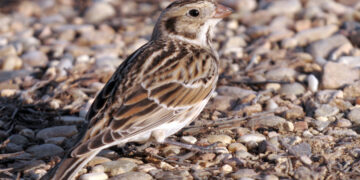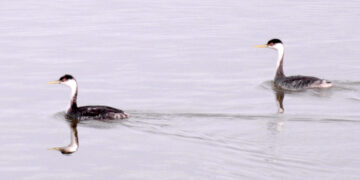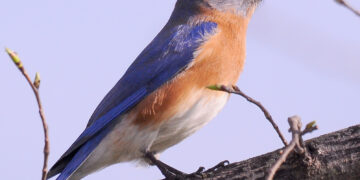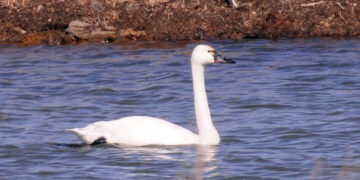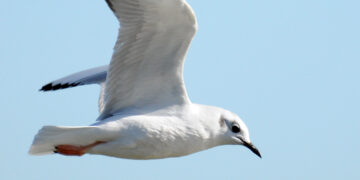I am not a fan of putting the word common in front of the names of animal species. It makes it sound as if they’re a dime a dozen.
And the birds with “common” in the name are often not all that common.
This week’s bird has that moniker. And it certainly isn’t common in Oklahoma where it is a winter visitor.
It has been one of my favorite birds since I first saw the movie, “On Golden Pond,” which featured loons quite a bit. Their sleek look and haunting calls have fascinated me ever since. I have always wanted to visit a northern lake in the summer to hear the birds’ evocative calls.
However, I have heard calls when I watch them at Lake of the Arbuckles in the Chickasaw National Recreation Area near Sulphur. They are an uncommon winter visitor there, but I almost always see at least a few there every winter.
The calls loons make in the winter are different and less powerful than the calls made during nesting season. But it is still fascinating to hear, nonetheless.
If you make a trip to the lake, I recommend having a good pair of binoculars. It is not easy to get close to a common loon.
However, these birds are quite common at Lake Hefner in Oklahoma City during the winter, and one can get somewhat close to them there. I know common loons visit Lake Lawtonka in the winter, but I am uncertain how numerous they are there.
Appearance
Loons are larger than mallards but smaller than most geese.
In summer, adults have a black head and bill, a black back with mesmerizing white spots, and the neck has areas striped with white – like a zebra pattern.
In the fall and winter, adults are drabber. They are gray on the back with a white throat and the bill is much lighter as well.
Diet
Loons eat fish such as perch and sunfish. They also will take crawdads, snails and leeches. Loons are expert anglers. They are certainly built for the job. Loons are heavy birds. Whereas most birds have hollow bones, loons have solid bones, the weight of which aids in underwater hunting.
Also, whereas many diving birds have paddle-like toes, loons have webbed feet, like a duck. And those feet are located quite far back on loons, which, big surprise, helps while they’re diving.
Loons hunting underwater is a sight to behold. I must admit, I’ve never submerged myself underwater and watched these birds hunting, but I have seen it through camera footage on nature programs.
Loons blaze through the water like torpedoes, and they can turn very quickly while pursuing fish.
Awkwardness
The fact that their feet are so far back on the body, combined with the heavy bodies, makes for walking on land clumsy and awkward.
In fact, according to National Geographic, this is where the name loon comes from. I guess someone back in the day thought the birds looked like they were out of their minds while walking and gave them that name. For this reason, loons must run along the water for quite some distance before taking flight.
Loons usually only go on land to mate and nest.
Calls
As I mentioned previously, the calls of common loons are haunting. According to the Minnesota Department of Natural Resources, the common loon has four calls.
To me, the long, drawn-out “wail” is the most haunting. It is the sound you would expect to hear in some scary movie! The “tremolo,” which sounds kind of like maniacal laughter, is an aggressive call. The “yodel” is sounded by male loons guarding their territory, and, to me, sounds like a series of screams. And the “hoot,” a shorter call, is used to communicate among parents and young and sounds like a little bark.
Threats
Sadly, while common loon populations are somewhat stable in most breeding areas, the populations in many northern and northwest states are declining or have disappeared altogether.
The good news is experts have identified what is causing the populations to decline and efforts are underway in some areas to lessen the threats to loons.
The major threats to these birds are lakeshore development, lead fishing weights (sinkers), habitat loss and mercury poisoning.
Loons must consume pebbles from the bottoms of lakes, etc. The pebbles are stored in crops and help with digestion. When the birds consume pebbles, they can inadvertently pick up lead sinkers, which will later kill them via lead poisoning.
Take Minnesota for instance. The land of 10,000 lakes also happens to have the largest common loon population in the lower 48 states with about 12,000 birds.
The loons are beloved in Minnesota. People there are taking steps to protect them. One way is by requiring steel sinkers while fishing in lakes populated by birds.
Another thing that hurts loons is development along lakeshores which can cause pollution and destroy nesting habitat.
Range
Common loons nest in portions of the northern United States, but the vast majority nest in Canada and Alaska. They winter along the coasts of Canada, the U.S. and Mexico, and often migrate through Oklahoma and will stay at area lakes for extended periods. They don’t really care for murky lakes. The clearer the water, the better.
Young loons are not ready to mate until they are several years old. Young ones will often migrate to coastal waters where they will live for up to two years before migrating back to the nesting areas. Once there, they will often wait at least a couple of more years before mating.
Odds and ends
• If you would like to hear the calls of common loons, the Internet is a good place to start. The Cornell Lab of Ornithology has a website called “All About Birds” which almost always features each bird’s sounds. You can also search YouTube for calls and video footage.
• According to the Cornell Lab of Ornithology, loons can quickly blow air out of their lungs and flatten their feathers to expel air within their plumage. This aids in their speed and agility while underwater. The loon’s heart slows down to conserve oxygen once it dives underwater.
• Cornell Lab reports that migrating common loons occasionally land on wet highways or parking lots, mistaking them for rivers and lakes. They become stranded without a considerable amount of open water for a long takeoff. Also, a loon may get stranded on a pond that is too small.
• And although they are heavy-bodied, common loons can fly very fast, between 75 and 100 miles per hour!
• Please don’t forget to check out my Randy’s Natural World YouTube channel at www.youtube.com/user/randyadventure. I’m making new videos as quickly as I can.
Editor’s Note: Randy Mitchell is a freelance writer and photographer. He has been an avid birdwatcher, nature enthusiast and photographer for more than 40 years. Reach him at rnw@usa.com.
Want to reach a local audience and grow your business?
Our website is the perfect platform to connect with engaged readers in your local area.
Whether you're looking for banner ads, sponsored content, or custom promotions, we can tailor a package to meet your needs.
Contact us today to learn more about advertising opportunities!
CONTACT US NOW

